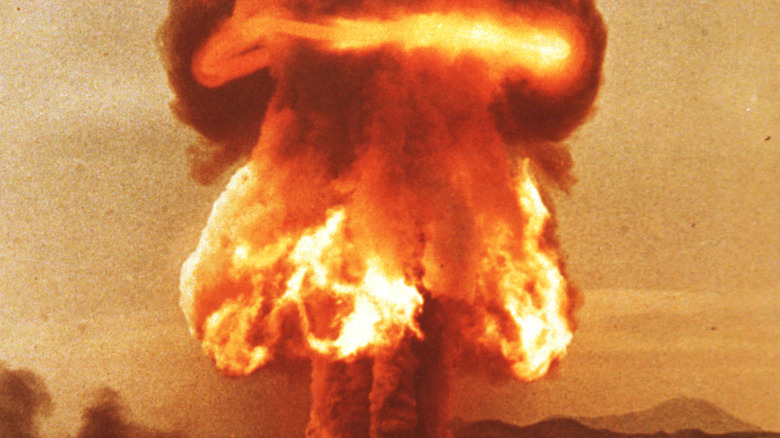Inside The Time The U.S. Lost A Hydrogen Bomb In The Ocean
In 1950, United States President Harry S. Truman approved the development of a hydrogen bomb after the Soviet Union detonated their first atomic bomb. The move was an attempt by America to show that they, too, had access to massive nuclear weapons capable of absolute destruction and a massive loss of human lives, per History. Of course, just five years before, the United States had performed the first nuclear test on July 16, 1945, in the New Mexico desert. This test was followed by the horrifying surprise attacks on the Japanese cities of Hiroshima and Nagasaki on August 6. The two atomic bombs dropped on the cities, nicknamed "Fat Man" and "Little Boy," ravaged the cities, killing 74,000 people in Hiroshima and 140,000 in Nagasaki. The attacks ended World War II with what historians have come to agree was an unnecessary amount of force, as reported by the Arms Control Association.
On November 1, 1952, the United States detonated the world's first hydrogen bomb on the Eniwetok Atoll in the Pacific Marshall Islands, instantly vaporizing an entire island. The bomb was named "Mike," carrying on the bizarre and disturbing trend of giving cutesy nicknames to deadly weapons. The Soviet Union followed suit three years later, dropping its own hydrogen bomb and bringing the possibility of a thermonuclear war to light for the first time in human history. Although a hydrogen bomb has yet to be used in battle, it has the potential to be 1,000 times more powerful than an atomic bomb and could kill everyone in a 5- to 10-mile radius, according to Time magazine. For comparison, the atomic bomb dropped in Nagasaki killed everyone within a mile radius.
A hydrogen bomb was lost in the sea for over 3 months
Considering the immense destructive capabilities of nuclear weapons, particularly hydrogen bombs, you'd think losing said weapons would be unthinkable. But as reported by History, the United States Pentagon admits to over 36 accidents in which a nuclear weapon was damaged or destroyed and caused nuclear contamination, or was just straight up lost. On January 27, 1966, a B-52 bomber on its way back to North Carolina crashed into a jet tanker over Spain during an attempt to refuel. The tanker exploded and killed all four of its crew members, while four of the seven B-52 crew parachuted to safety. There were four bombs on board; the explosive material in two of them fell to Earth and scattered radioactive plutonium over the fields of the village of Palomares (shown above). Another bomb was quickly recovered in a riverbed and the fourth was lost in the ocean.
Almost 2,000 members of the United States military arrived to clean and decontaminate the area along with a group of Spanish civil guards. As the Spanish guards didn't have experience with radioactive materials, they didn't know to take precautions and prevent personal exposure. Over 1,400 tons of radioactive material ended up getting shipped to the United States. Eventually, a Spanish fisherman who saw the bomb fall led the United States Navy to a 1-mile area where he believed it was located. The weapon was spotted by a submarine on March 15 and recovered on April 7, damaged but whole. The United States eventually settled over 500 claims from Palomares residents whose health suffered due to the accident.

